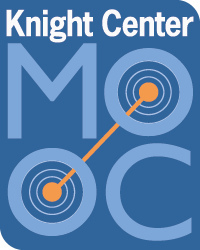

The Knight Center for Journalism in the Americas concluded this week its largest class to date: The second edition of its first Massive Open Online Course (or MOOC), “Introduction to Infographics and Data Visualization” with instructor Alberto Cairo. The MOOC attracted more than 5,000 participants from 138 countries in its second iteration (the first edition of the course reached out 2,000 people from 109 countries last year).
The MOOC began on Jan. 12 and was planned to end on February 23, but was extended due to intense participation of students and the need for more time for assignments. Officially, the MOOC concluded on March 5 with Cairo’s last interactions with the students. The course was a continuation of the Knight Center’s new MOOC initiative, which began in October last year, and a successful escalation in the number of students the Knight Center would accept at the same time.
“As far as we know, this was the first MOOC on journalism in the world. It is amazing that it could reach out more than 7,000 people in its two editions. More than half of the countries in the world had representatives in both courses, which is also impressive,” said professor Rosental Alves, founder and director of the Knight Center. “This first MOOC was an experiment and I can now say that it was a big success. We proved the concept and now we are preparing several other MOOCs on journalism topics, like the one on election coverage, in Spanish, that we launch this weekend.”
Professor Alves said that about half of the more than 5,000 participants of the MOOC were engaged in the discussion forums. “The fact that 2,214 people interacted in the forums of the course is really a good indicator of the effectiveness of the MOOC. We had 9,992 posts in the forums during the course and the Instructor, Alberto Cairo, responded directly or collectively to hundreds of them,” he said.
The Knight Center’s first massive-format course, the first edition of “Introduction to Infographics and Data Visualization,” was launched in October last year and concluded in December. It attracted more than 2,000 participants, obtained outstanding reviews and was so popular that the Knight Center expanded the capacity of its servers to offer the course a second time to more students. Just like the first edition of the course, Cairo’s second class included readings, video lectures and tutorials, and focused on how to work with graphics to communicate and analyze data.
In his final message to the class, Cairo said the class benefitted from the variety in the professional and cultural backgrounds of the students.
“People from more than 100 countries have participated in this MOOC. We’ve had journalists, designers, scientists, economists, statisticians, developers, etc. This fact has made the course much richer and more engaging. It would not have been so interesting if the student body were not so diverse,” Cairo wrote.
Some of the final projects reviewed by Cairo included infographics on teen pregnancy in the U.K., prejudice against homosexuality in the U.S., and one student’s personal gasoline expenses over several years.
“The nicest thing about this course is that every student got something different from it,” Cairo said. “Students with no knowledge at all at the very beginning got a basic understanding of what graphs, maps, and diagrams are for, while those who came to the course with a more extensive background in the field probably now have a better grasp of good practices and effective techniques.”
A MOOC is a new type of online learning program that was designed to reach a large number of students. In general, most MOOCs are college courses that have been recorded on video and adapted to be shared over the Internet.
The Knight Center’s pioneering MOOC program has been designed especially for this new, massive format and seeks to encourage the largest amount of student-to-student and instructor-to-students interactions as possible. On March 8 the Knight Center will launch its first MOOC in Spanish, “How to Improve Electoral Coverage.” Click here for more information.

Cairo is a renowned expert in the field of infographics. He is currently a professor at the University of Miami’s School of Communication and has taught several regular online courses at the Knight Center’s distance learning platform. Chapters of Cairo’s new book, The Functional Art are used in the course. He also uses his Twitter account @AlbertoCairo to complement class discussions.
The Knight Center for Journalism in the Americas was created in 2002 by Professor Rosental Alves at the University of Texas at Austin School of Journalism thanks to a generous donation from the John S. and James L. Knight Foundation, which has been supporting it continually. The Center also receives major contributions from the Open Society Foundations and The University of Texas at Austin. The Center’s main goal is to help journalists in Latin American and the Caribbean to improve the quality of journalism in their countries.